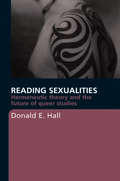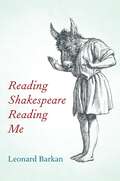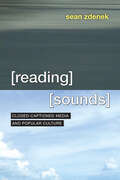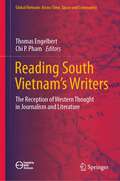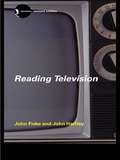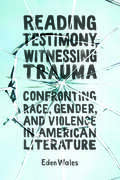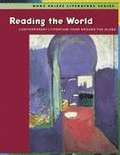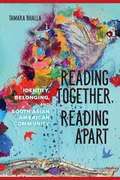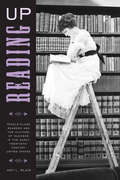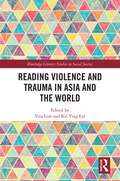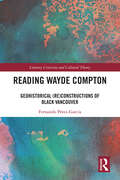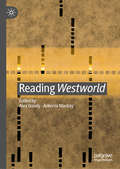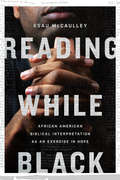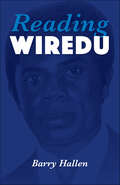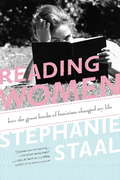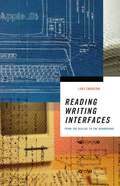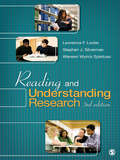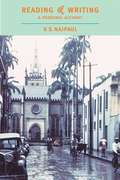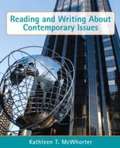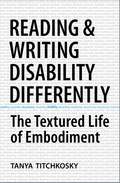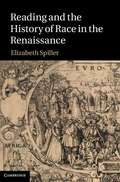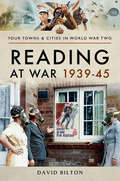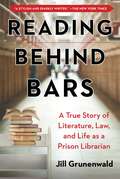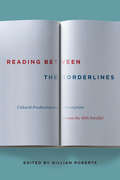- Table View
- List View
Reading Sexualities: Hermeneutic Theory and the Future of Queer Studies
by Donald E. HallReading Sexualities confronts the reigning practices, priorities, and preoccupations of queer theory and sexuality studies. Looking at a range of texts, from novels to travel narratives to internet porn, Donald E. Hall deftly weaves the theoretical with the literary in order to: examine the vexed ethical, critical, and political questions arising from sexual consumerism and cross-cultural encounters read the changing landscape of sexual identity, finding great cause for optimism and enthusiastic engagement urge readers to embrace a far-reaching dialogic practice as a mechanism for furthering radical social change. Reading Sexualities shows how our sexual desires and bases for identification are being widely challenged and changed. Drawing on hermeneutic theory and the work of Hans-Georg Gadamer, Hall argues that by approaching sexual diversity with openness and humility, we become active participants in the politically urgent process of reading the self through the perspective of the other.
Reading Shakespeare Reading Me
by Leonard BarkanA gripping, funny, joyful account of how the books you read shape your own life in surprising and profound ways.Bookworms know what scholars of literature are trained to forget: that when they devour a work of literary fiction, whatever else they may be doing, they are reading about themselves. Read Shakespeare, and you become Cleopatra, Hamlet, or Bottom. Or at the very least, you experience the plays as if you are in a small room alone with them, and they are speaking to your life, your sensibility.Drawing on fifty years as a Shakespearean, Leonard Barkan has produced a captivating book that asks us to reconsider what it means to read. Barkan violates the rule of distance he was taught and has always taught his students. He asks: Where does this brilliantly contrived fiction actually touch me? Where is Shakespeare in effect telling the story of my life?King Lear, for Barkan, raises unanswerable questions about what exactly a father does after planting the seed. Mothers from Gertrude to Lady Macbeth are reconsidered in the light of the author’s experience as a son of a former flapper. The sonnets and comedies are seen through the eyes of a gay man who nevertheless weeps with joy when all the heterosexual couples are united at the end. A Midsummer Night’s Dream is interpreted through the author’s joyous experience of performing the role of Bottom and finding his aesthetic faith in the pantheon of antiquity. And the exquisitely poetical history play Richard II intersects with, of all things, Ru Paul’s Drag Race.Full of engrossing stories, from family secrets to the world of the theater, and written with humor and genuine excitement about literary experiences worthy of our attention and our love, Reading Shakespeare Reading Me makes Shakespeare’s plays come alive in new ways.
Reading Sideways: The Queer Politics of Art in Modern American Fiction
by Dana SeitlerReading Sideways explores the pivotal role that various art forms played in American literary fiction in direct relation to the politics of gender and sexuality in works of modern American literature. It tracks the crosswise circulation of aesthetic ideas in fiction and argues that at stake in the aesthetic turn of these works was not only the theorization of aesthetic experience but also an engagement with political arguments and debates about available modes of sociability and sexual expression. To track these engagements, its author, Dana Seitler, performs a method she calls “lateral reading,” a mode of interpretation that moves horizontally through various historical entanglements and across the fields of the arts to make sense of—and see in a new light—their connections, challenges, and productive frictions. Each chapter takes a different art form as its object: sculpture, portraiture, homecraft, and opera. These art forms appear in some of the major works of literature of the period central to negotiations of gender, race, and sexuality, including those by Henry James, Davis, Willa Cather, Du Bois, Sarah Orne Jewett, and Mary Wilkins Freeman. But the literary texts that each chapter of this book takes as its motivation not only include a specific art form or object as central to its politics, they also build an alternative aesthetic vocabulary through which they seek to alter, challenge, or participate in the making of social and sexual life. By cultivating a counter-aesthetics of the unfinished, the uncertain, the small, the low, and the allusive, these fictions recognize other ways of knowing and being than those oriented toward reductively gendered accounts of beauty, classed imperatives established by the norms of taste, or apolitical treatises of sexual disinterestedness. And within them—and through “reading sideways”—we can witness the coming-into-legibility of a set of diffuse practices that provide a pivot point for engaging the political methods of minoritized subjects at the turn of the twentieth century.
Reading Sounds: Closed-Captioned Media and Popular Culture
by Sean ZdenekImagine a common movie scene: a hero confronts a villain. Captioning such a moment would at first glance seem as basic as transcribing the dialogue. But consider the choices involved: How do you convey the sarcasm in a comeback? Do you include a henchman's muttering in the background? Does the villain emit a scream, a grunt, or a howl as he goes down? And how do you note a gunshot without spoiling the scene? These are the choices closed captioners face every day. Captioners must decide whether and how to describe background noises, accents, laughter, musical cues, and even silences. When captioners describe a sound--or choose to ignore it--they are applying their own subjective interpretations to otherwise objective noises, creating meaning that does not necessarily exist in the soundtrack or the script. Reading Sounds looks at closed-captioning as a potent source of meaning in rhetorical analysis. Through nine engrossing chapters, Sean Zdenek demonstrates how the choices captioners make affect the way deaf and hard of hearing viewers experience media. He draws on hundreds of real-life examples, as well as interviews with both professional captioners and regular viewers of closed captioning. Zdenek's analysis is an engrossing look at how we make the audible visible, one that proves that better standards for closed captioning create a better entertainment experience for all viewers.
Reading South Vietnam's Writers: The Reception of Western Thought in Journalism and Literature (Global Vietnam: Across Time, Space and Community)
by Chi P. Pham Thomas EngelbertThis edited book examines how South Vietnam’s (formerly the Republic of Vietnam 1955-1975) literary and journalistic writers were perceived and - potentially - influenced by Western thought, led by thinkers such as Jean-Paul Sartre, Franz Kafka, Sigmund Freud, Thomas Mann, Martin Heidegger, Hermann Hesse, Edmund Husserl, Stefan Zweig, Graham Greene, and Somerset Maugham. The book reveals the dynamism and diversity of Western thought in individual literary texts, as well as among the authors themselves. The volume considers how writers and their texts engaged with issues that are socially, culturally, politically, and philosophically significant to Vietnam and beyond, past and present. This approach to South Vietnam’s literary and journalistic tradition enables an alternative plural, inclusive view of the significance of these texts, which are shown to be neither exclusively anti-Communist nor “bourgeois individualist” (cá nhân tiểu tư sản), as they have so often been interpreted both in and outside of Vietnam. Such an interpretation problematically retains the marginal position of South Vietnam’s literature in mainstream Vietnamese literature, and in the literatures of the host countries where these Vietnamese authors have migrated, settled, and continued to write following the 'Fall of Saigon'. This volume presents itself as a key text for those studying Asian and postcolonial literatures, as well as scholars in the humanities researching Vietnam – its history, politics, society, and culture.
Reading Television
by John FiskeFirst published in 2004. Routledge is an imprint of Taylor & Francis, an informa company.
Reading Testimony, Witnessing Trauma: Confronting Race, Gender, and Violence in American Literature
by Eden WalesWinner of the 2020 Eudora Welty PrizeTheorists emphasize the necessity of writing about—or witnessing—trauma in order to overcome it. To this critical conversation, Reading Testimony, Witnessing Trauma: Confronting Race, Gender, and Violence in American Literature treats reader response to traumatic and testimonial literature written by and about African American women and adds insight into the engagement of testimonial literature. Eden Wales articulates a theory of reading (or dual-witnessing) that explores how narrators and readers can witness trauma together. She places these original theories of traumatic reception in conversation with the African American literary tradition to speak to the histories, cultures, and traumas of African Americans, particularly the repercussions of slavery, as witnessed in African American literature. The volume also considers intersections of race and gender and how narrators and readers can cross such constructs to witness collectively. Reading Testimony, Witnessing Trauma’s innovative examinations of raced-gendered intersections open and speak with those works that promote dual-witnessing through the fraught (literary) histories of race and gender relations in America. To explicate how dual-witnessing converses with American literature, race theory, and gender criticism, the book analyzes emancipatory narratives by Sojourner Truth, Harriet Jacobs, and Elizabeth Keckley and novels by William Faulkner, Zora Neale Hurston, Margaret Walker, Toni Morrison, and Jesmyn Ward.
Reading The World: Contemporary Literature From Around The Globe (Many Voices Literature Series)
by PLC Editors Staff PerfectionIn Reading the World: Contemporary Literature from Around the Globe, you will hear the familiar sound of English, but in tones and accents that have the flavor of elsewhere. The writers come from all over the world—China, Nigeria, Syria, Ireland, and Argentina—and include Nobel Prize winners along with other outstanding writers from the last one hundred years.
Reading Together, Reading Apart: Identity, Belonging, and South Asian American Community (The Asian American Experience)
by Tamara BhallaOften thought of as a solitary activity, the practice of reading can in fact encode the complex politics of community formation. Engagement with literary culture represents a particularly integral facet of identity formation--and serves as an expression of a sense of belonging--within the South Asian diaspora in the United States. Tamara Bhalla blends a case study with literary and textual analysis to illuminate this phenomenon. Her fascinating investigation considers institutions from literary reviews to the marketplace and social media and other technologies, as well as traditional forms of literary discussion like book clubs and academic criticism. Throughout, Bhalla questions how her subjects' circumstances, shared race and class, and desires limit the values they ascribe to reading. She also examines how ideology circulating around a body of literature or a self-selected, imagined community of readers shapes reading itself and influences South Asians' powerful, if contradictory, relationship with ideals of cultural authenticity.
Reading Up: Middle-Class Readers and the Culture of Success in the Early Twentieth-Century United States
by Amy BlairA person who reads a book for self-improvement rather than aesthetic pleasure is “reading up.” Reading Up is Amy Blair's engaging study of popular literary critics who promoted reading generally and specific books as vehicles for acquiring cultural competence and economic mobility. Combining methodologies from the history of the book and the history of reading, to mass-cultural studies, reader-response criticism, reception studies, and formalist literary analysis, Blair shows how such critics influenced the choices of striving readers and popularized some elite writers. Framed by an analysis of Hamilton Wright Mabie's role promoting the concept of “reading up” during his ten-year stint as the cultivator of literary taste for the highly popular Ladies' Home Journal, Reading Up reveals how readers flocked to literary works that they would be expected to dislike. Blair shows that while readers could be led to certain books by a trusted adviser, they frequently followed their own path in interpreting them in unexpected ways.
Reading Violence and Trauma in Asia and the World (Routledge Literary Studies in Social Justice)
by Yiru Lim Kit Ying LyeThis collection casts the spotlight on Asia and its place in global studies on trauma to explore the ways in which violence and trauma are (re)enacted, (re)presented, (re)imagined, reconciled, and consumed through various mediums in the region. The discussions revolve around the ethics of representing and discussing trauma as we negotiate the tensions between trauma and political, historical, literary, and cultural representations in written, visual, digital, and hybrid forms. It examines how perspectives about trauma are framed, perpetuated, and/or critiqued via theories and research methods, and how a constructive tension between theory, method, and experience is essential for critical discourse on the subject. It will discuss varied ways of understanding violence through multidisciplinary perspectives and comparative literature, explore the "violent psyches" of narratives and writings across different mediums and platforms, and engage with how violence and trauma continue to influence the telling and form of such narratives.
Reading Wayde Compton: Geohistorical (Re)Constructions of Black Vancouver (Literary Criticism and Cultural Theory)
by Fernando Pérez-GarcíaThis book is a comprehensive analysis of the literary oeuvre of Wayde Compton, examining the interplay between modes of literary production, urban commemoration, the formation of Black racial identity on the margins of the diaspora, and coalitions of solidarity with other communities in Vancouver.Stemming from an interdisciplinary perspective that blends Spatial Literary Studies, Hip hop epistemology, and the transmodern paradigm, this book presents a dynamic model of Black identity formation and belonging, resulting from the remix of Afro-diasporic and transcultural elements and the political commemoration of local Black spaces in an often-understudied node of the Black diaspora. This book also explores Compton’s contribution to recent academic debates on the interaction between the commemoration of Black spaces and the right to the city, as well as the engagement with Indigenous calls for the decolonisation of their ancestral lands. The analysis of Compton’s work allows for the deconstruction of the binaries African/Canadian, Indigenous/settler, Hogan’s Alley/Vancouver and exposes the co-constitutive character of these elements.
Reading Westworld
by Alex Goody Antonia MackayReading Westworld is the first volume to explore the cultural, textual and theoretical significance of the hugely successful HBO TV series Westworld. The essays engage in a series of original enquiries into the central themes of the series including conceptions of the human and posthuman, American history, gaming, memory, surveillance, AI, feminism, imperialism, free will and contemporary capitalism. In its varied critical engagements with the genre, narratives and contexts of Westworld, this volume explores the show’s wider and deeper meanings and the questions it poses, as well considering how Westworld reflects on the ethical implications of artificial life and technological innovation for our own futurity. With critical essays that draw on the interdisciplinary strengths and productive intersections of media, cultural and literary studies, Reading Westworld seeks to respond to the show’s fundamental question; “Have you ever questioned the nature of your reality?” It will be of interest to students, academics and general readers seeking to engage with Westworld and the far-reaching questions it poses about our current engagements with technology.
Reading While Black: African American Biblical Interpretation as an Exercise in Hope
by Esau McCaulleyGrowing up in the American South, Esau McCaulley knew firsthand the ongoing struggle between despair and hope that marks the lives of some in the African American context. A key element in the fight for hope, he discovered, has long been the practice of Bible reading and interpretation that comes out of traditional Black churches. This ecclesial tradition is often disregarded or viewed with suspicion by much of the wider church and academy, but it has something vital to say. Reading While Black is a personal and scholarly testament to the power and hope of Black biblical interpretation. At a time in which some within the African American community are questioning the place of the Christian faith in the struggle for justice, New Testament scholar McCaulley argues that reading Scripture from the perspective of Black church tradition is invaluable for connecting with a rich faith history and addressing the urgent issues of our times. He advocates for a model of interpretation that involves an ongoing conversation between the collective Black experience and the Bible, in which the particular questions coming out of Black communities are given pride of place and the Bible is given space to respond by affirming, challenging, and, at times, reshaping Black concerns. McCaulley demonstrates this model with studies on how Scripture speaks to topics often overlooked by white interpreters, such as ethnicity, political protest, policing, and slavery. Ultimately McCaulley calls the church to a dynamic theological engagement with Scripture, in which Christians of diverse backgrounds dialogue with their own social location as well as the cultures of others. Reading While Black moves the conversation forward.
Reading Wiredu (World Philosophies)
by Barry HallenReading Wiredu is the first comprehensive overview of the philosophical thought of Kwasi Wiredu. Born in Ghana in 1931, Wiredu, an important observer and critic of philosophy generally, remains an original and penetrating African thinker. Interrelating Wiredu's philosophical writings from across decades, Barry Hallen sets forth the basic tenets and the defining features of his philosophy. Wiredu's thought is divided into five distinct but interconnected areas: his response to the philosophy of Quine on issues of logic and ontology, issues of language in philosophical reflection, the nature of truth as a practical and philosophical concern, the principle of sympathetic impartiality that all human beings must live by to survive as a group, and finally, consensus building as rooted in intentional, negotiated, and rational exchanges that are part of everyday life. Reading Wiredu explores the scope and depth of Wiredu's philosophical thought, which can be framed through what he calls a genetic methodology—a methodology that privileges environmental considerations in the production of various forms of thought. Hallen's overview is intended to assist scholars and students in grasping Wiredu's complex philosophical thought.
Reading Women: How the Great Books of Feminism Changed My Life
by Stephanie StaalWhen Stephanie Staal first read The Feminine Mystique in college, she found it "a mildly interesting relic from another era. ” But more than a decade later, as a married stay-at-home mom in the suburbs, Staal rediscovered Betty Friedan’s classic work-and was surprised how much she identified with the laments and misgivings of 1950s housewives. She set out on a quest: to reenroll at Barnard and re-read the great books she had first encountered as an undergrad. From the banishment of Eve to Judith Butler’s Gender Trouble, Staal explores the significance of each of these classic tales by and of women, highlighting the relevance these ideas still have today. This process leads Staal to find the self she thought she had lost-curious and ambitious, zany and critical-and inspires new understandings of her relationships with her husband, her mother, and her daughter.
Reading Writing Interfaces: From the Digital to the Bookbound (Electronic Mediations #44)
by Lori EmersonLori Emerson examines how interfaces—from today&’s multitouch devices to yesterday&’s desktops, from typewriters to Emily Dickinson&’s self-bound fascicle volumes—mediate between writer and text as well as between writer and reader. Following the threads of experimental writing from the present into the past, she shows how writers have long tested and transgressed technological boundaries.Reading the means of production as well as the creative works they produce, Emerson demonstrates that technologies are more than mere tools and that the interface is not a neutral border between writer and machine but is in fact a collaborative creative space. Reading Writing Interfaces begins with digital literature&’s defiance of the alleged invisibility of ubiquitous computing and multitouch in the early twenty-first century and then looks back at the ideology of the user-friendly graphical user interface that emerged along with the Apple Macintosh computer of the 1980s. She considers poetic experiments with and against the strictures of the typewriter in the 1960s and 1970s and takes a fresh look at Emily Dickinson&’s self-printing projects as a challenge to the coherence of the book.Through archival research, Emerson offers examples of how literary engagements with screen-based and print-based technologies have transformed reading and writing. She reveals the ways in which writers—from Emily Dickinson to Jason Nelson and Judd Morrissey—work with and against media interfaces to undermine the assumed transparency of conventional literary practice.
Reading and Understanding Research
by Lawrence F. Locke Waneen W. Spirduso Stephen SilvermanIdeal for students, novice researchers, or professionals, this indispensable resource serves as a road map for readers who need to analyze and apply research findings. It helps them think critically about the credibility of what they are reading by showing them how to identify problems and develop constructive questions.Key FeaturesAssumes no prior knowledge of research proceduresProvides readers with a step-by-step format for decoding the complex language and formats used in reports and reviewsIncludes the most common formats for both quantitative and qualitative inquiryOffers both illustrative examples and powerful training exercisesGives specific attention to strategies for critically appraising reported researchPresents completely updated references as well as an annotated bibliographyIntended AudienceThis text is appropriate for both upper-level undergraduate and graduate students across the social sciences enrolled in introductory research courses as well as students in professional preparation programs.
Reading and Writing
by V. S. NaipaulThe esteemed writer prepared this essay of literary autobiography, in which he discusses his personal development as a writer, for the Charles Douglas-Home Memorial Trust.
Reading and Writing About Contemporary Issues
by Kathleen T. McwhorterReading and Writing About Contemporary Issues offers an integrated approach to reading and writing using a handbook for reference and instruction followed by readings for analysis and writing.
Reading and Writing Disability Differently: The Textured Life of Embodiment
by Tanya TitchkoskyIn this study, Titchkosky analyzes the depiction of disabled people in the mass media. Through an examination of everyday texts such as news stories and government surveys, she uncovers and critiques a Western cultural assumption that sees disability as a clear-cut "problem" in need of a solution. Titchkosky (disability studies, U. of Toronto) is also the author of Disability, Self, and Society (2003). Annotation ©2007 Book News, Inc., Portland, OR (booknews.com)
Reading and the History of Race in the Renaissance
by Elizabeth SpillerElizabeth Spiller studies how early modern attitudes towards race were connected to assumptions about the relationship between the act of reading and the nature of physical identity. As reading was understood to happen in and to the body, what you read could change who you were. In a culture in which learning about the world and its human boundaries came increasingly through reading, one place where histories of race and histories of books intersect is in the minds and bodies of readers. Bringing together ethnic studies, book history and historical phenomenology, this book provides a detailed case study of printed romances and works by Montalvo, Heliodorus, Amyot, Ariosto, Tasso, Cervantes, Munday, Burton, Sidney and Wroth. Reading and the History of Race traces ways in which print culture and the reading practices it encouraged, contributed to shifting understandings of racial and ethnic identity.
Reading at War, 1939–45 (Towns & Cities in World War Two)
by David BiltonA history of life in the southern English town during World War II.As in the Great War, Reading in the Second World War was a town permanently in a state of flux. So close to London, so easily pinpointed by its proximity to the Thames, with railway lines converging near the town center and with much of the town’s industry geared up to essential war work, it was an obvious target for the German Luftwaffe when the war broke out. Knowing this, the council had set up an efficient civil defense system aided by government finance. Fortunately for the citizens, although they were bombed on many occasions, only one raid had any significant impact.The book covers the daily life of a town ready for the worst, but one that continued with its daily life and just got on with its efforts to aid the war effort. The book is profusely illustrated with photographs, illustrations and human interest stories. Much of the material used has not been seen since the war so it provides a valuable and unique insight into daily life of the town.“David Bilton takes an in-depth look at how the people of Reading coped during the conflict. Interesting to read that suffering from German Air Raids was apparently minimal, and the photographs, as always, are fascinating to see. A brilliant series.” —Books Monthly (UK)
Reading behind Bars: A True Story of Literature, Law, and Life as a Prison Librarian
by Jill GrunenwaldIn December 2008, twentysomething Jill Grunenwald graduated with her master’s degree in library science, ready to start living her dream of becoming a librarian. But the economy had a different idea. As the Great Recession reared its ugly head, jobs were scarce. After some searching, however, Jill was lucky enough to snag one of the few librarian gigs left in her home state of Ohio. The catch? The job was behind bars as the prison librarian at a men’s minimum-security prison. Talk about baptism by fire. As an untested twentysomething woman, to say that the job was out of Jill’s comfort zone was an understatement. She was forced to adapt on the spot, speedily learning to take the metal detectors, hulking security guards, and colorful inmates in stride. Over the course of a little less than two years, Jill came to see past the bleak surroundings and the orange jumpsuits and recognize the humanity of the men stuck behind bars. They were just like every other library patron—persons who simply wanted to read, to be educated and entertained through the written word. By helping these inmates, Jill simultaneously began to recognize the humanity in everyone and to discover inner strength that she never knew she had. At turns poignant and hilarious, Reading behind Bars is a perfect read for fans of Orange is the New Black and Shakespeare Saved My Life.
Reading between the Borderlines: Cultural Production and Consumption across the 49th Parallel
by Gillian RobertsIs Superman Canadian? Who decides, and what is at stake in such a question? How is the Underground Railroad commemorated differently in Canada and the United States, and can those differences be bridged? How can we acknowledge properly the Canadian labour behind Hollywood filmmaking, and what would that do to our sense of national cinema? Reading between the Borderlines grapples with these questions and others surrounding the production and consumption of literary, cinematic, musical, visual, and print culture across the Canada-US border. Discussing a range of popular as well as highbrow cultural forms, this collection investigates patterns of cross-border cultural exchange that become visible within a variety of genres, regardless of their place in any arbitrarily devised cultural hierarchy. The essays also consider the many interests served, compromised, or negated by the operations of the transnational economy, the movement of culture's "raw material" across nation-state borders in literal and conceptual terms, and the configuration of a material citizenship attributed to or negotiated around border-crossing cultural objects. Challenging the oversimplification of cultural products labelled either "Canadian" or "American," Reading between the Borderlines contends with the particularities and complications of North American cultural exchange, both historically and in the present.
